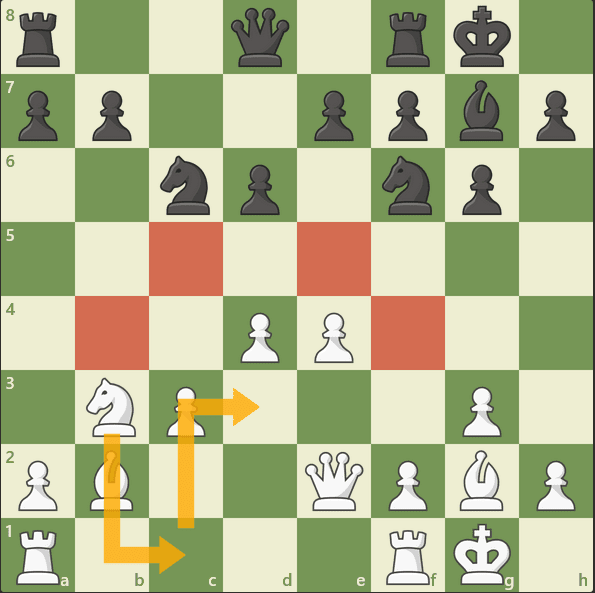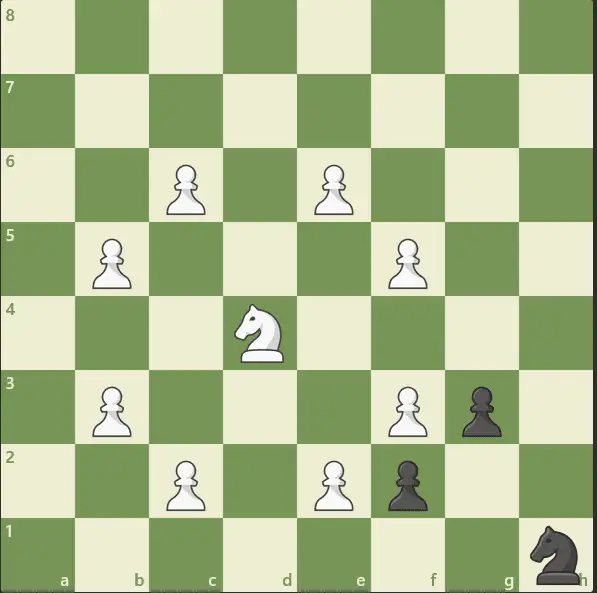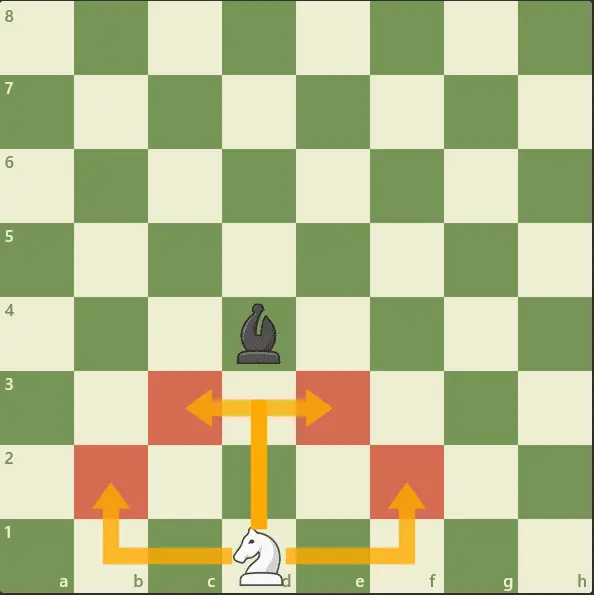How to use the knights effectively in chess? (Tips!)
The Knight definitely is the most intimidating piece that one needs to grasp in their journey to learn chess. I personally have brewed some trouble early on the process specifically on this piece.
I am sure many people share my sentiments, and I want to share things that I have learned on this mystical yet confusing horse-looking piece.
But first we need to understand how the knight moves and captures, this is what I know.
Knights in chess move in an L-shape pattern spanning two tiles in any direction and 1 tile to its side (making an L-shape movement). Knights will capture this way and is the only piece that can jump over blockading pawn/pieces.
This is quite a weird movement patteen. L-shape is not exactly a common movement type, this is why people find the knight the hardest to master among all of the pieces in chess. What if I tell you there are ways to make this easier?
Utilizing the knight don’t have to be difficult, you only nee to understand a couple of things. I will prove it in this article. Learning this though is the first step to actually start mastering them as soon as possible.
Let’s get talking.
How can the Knight be effective in the opening?
The opening phase of the game is the most effective stage of the game where the Knight can unleash its full potential. After all, many pawns are present at this particular time where the knight’s ability to jump becomes very useful.
To use the Knight effectively in the opening one needs to develop them early towards the center (getting them out of their starting tiles) and improve their position afterward by possibly looking for moves with the Knight back.
Learning these ideas is critical since this is the field where the Knight actually shines, the player who can effectively make use of the Knight at this phase would likely have the advantage.
You have to develop the Knights early in preference to the center area of the board where they can control a lot of spaces. Most moves in the opening involve a knight developing scheme which tells you how important they are.
The Knights are really easy to develop at this point, one move is all it takes to get it going unlike other pieces (since it can jump). This fact alone should be enough to make you prioritize developing this piece more than any other option out there.
The next idea is identifying possible moves with the Knight’s back tiles. I say this specifically since moves with the Knight back are really notorious for finding the right squares for the Knight.
Don’t get me wrong though I don’t mean to retreat the Knight to its original square but rather using other back tiles as a maneuver point. Take at look at this example:

The white knight on b3 is a fairly developed knight that has already gotten out of its starting square, but can still be further improved. Knight b3 going to the back tile (c1) can allow it to access the juicy c3 square which is an excellent coordinate that controls many important spaces.
Don’t get me wrong this is not by any means the absolute best move for the knight in every eatly phases but it definitely is a good consideration.
“According to my experience in chess, the most difficult in chess? To see moves with knight back.”
-Vassily Ivanchuk (Chucky)
Where do the Knights achieve their full potential?
The knight is a very special piece that it can be the most efficient one depending solely on its closeness to the center.
The Knights can achieve their full potential if located towards or near the center rather than the edge, especially if it is defended by a pawn and no enemy pawns can dislodge it from its position.
In order to use the Knight effectively, it is imperative to never allow it to stay on the edge for as long as possible (although there are positions that may warrant this). The knight on the sides just doesn’t have that much influence to offer than the one at the center.
Here is good illustration of what that actually looks like:

You see the white knight on d4 (near the center) has a monstrous reach that would definitely cause some problems due to its possible combinations. The knight on h1 on the other hand (at the edge) is not really pleasant-looking and would likely not accomplish much due to its position.
This is why it’s important to keep the Knight away from the corner to unleash its full potential. It’s really hard to imagine a knight from the edge having a lot of work in there (there are rare exceptions).
“Knight on the rim is dim.”
-Siegbert Tarrasch
Another concept I want to introduce is the art of looking for excellent knight outpost. This is a spot where a knight that is supported by a pawn is unlikely to be take away by enemy pawns or pieces.
In fact, most of the early phase of the game is spent looking for these sweet spots (outposts) since the knight is just so much powerful in this mode. And since the knight is the only piece that could not be blocked, this idea is helpful in positions that are closed/semi-closed.
This could also be applied in open positions too since a knight in a good tile just allows it to be more influential in general. You’d naturally develop the ability to recognize these spaces and exploit them with experience and some knowledge.
How to effectively fork with the Knight?
A fork with the Knight specifically is an important chess tactic that involves the said piece having a multi-attack on 2 or more pieces from just one tile.
To effectively fork with the Knight you can try to take advantage of the early c-pawn weakness of the king and rook early in the game, supported its landing square with a Bishop or another Knight, or just improve your visualization in general.
This is a very famous capability that made the Knight notorious in lower elo games but also occasionally at higher stages. The ability to fork separate it from any other piece due to the easiness of performing a double attack (or a multi-attack).
Don’t get me wrong other pieces can execute such things too just not as frequent as the Knight. And along with its confusing playing patterns, it makes it more likely to actually occur than any other piece.
You have to master identifying forks to use the knight effectively which would take some experience but also targeted practice. I recommend playing chess puzzles for those chess rushes (like the one at chess.com) which usually involves this idea.
I believe improving your tactical visualization in general can in itself enable you to identify forks when they are possible.
How does the Knight relate to the Bishop?
The Knight can only jump to the opposite color from where it used to reside. This makes the bishop able to control the Knight in a special positions where it cannot move without being captured.
This is an important relationship between the Knight and the Bishop commonly witnessed in endgames where it is much more significant. This is one of the reasons why the Knight is usually considered less superior at the later stages of the game.
Take a look at the diagram below:

The white Knight on d1 is stuck on the edge where it is less powerful (away from the center), but even worse the black bishop at d4 order limit its future by controlling the possible squares it can go into. This is what I mean by the relationship between the Knight and the bishop where one has the potential to completely shut down the other.
In order to use the Knight effectively you should be able to evade such positions especially in the endgame (where it is most common). This can be done by keeping away from the edge of the board where these situations can occur.
But that is the endgame, is the Knight inherently inferior to the Bishop? In order to get a more thorough explanation (bishop vs. knight), you should read this article (will open in a new tab).
But to summarize the Bishop has a lot more characteristics to have the advantage in most positions than the Knight (there are rare exceptions) and thus should be treated so.
In other words, you can actually afford to trade the Knight for the bishop since it would count as a good trade. Of course your opponent most likely wouldn’t allow it, but just the very fact alone means that you should use the Knight to harass the bishop early on.
One of the key components to use it effectively is to actually exchange it for an opponent’s bishop.
What are the weaknesses of the Knight?
The Knight adding to the element of its confusing pattern has a very limited movement option that it can perform making it vulnerable to being trapped.
All It takes is a deliberate attempt to cover the Knight’s escape tiles with pawns and it usually gets the job done. A Knight in the corner especially is much easier to trap not even with the help of the bishop since it has so many fewer opportunities to run from attacks.
By just being aware of this weakness, you would be much more careful of where you would actually place the Knight more than any other piece. Which brings us to the next point.
Do not make both Knights defend each other, it just makes them more vulnerable to being picked up. If one of the Knights is under supervision by any of the opponent’s pieces, then all it takes is dislodging one of them to hang one of the Knights (Knights are usually kicked away with the pawns).
This of course is much more acceptable in the earlier phase of the game since that rarely occurs at that point. However when the middlegame comes you should limit Knights that defend each other due to this weakness.
And lastly if you want to improve with the Knight, learn to familiarize with its general L-shape pattern movement by playing more games. This is the bulk of the reason why most people tend to not bring the Knight’s full potential.
All of the strategies and techniques that have been discussed here will be all for naught if you can’t get used to the Knight’s movement patterns. I recommend studying tactics/puzzles involving the Knight or again, to play more games to get that chess juice flowing.
Can you use the Knight effectively?
All the things that I’ve talked about here are just from my general experience and insights their could possibly be more. But what I’m sure of is the Knight is usually the piece that most people struggle with.
This general guideline if followed should provide a sufficient baseline to improve people’s play as much as possible. Plus they are not that hard to implement as well.
Try it in your own games and you should be able to understand the practicality of most suggestions here. But then again, it’s all up to you on how this knowledge could be harnessed to make the Knight hoofing, Sleep well and play chess.
